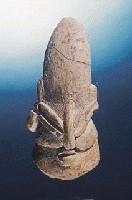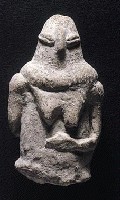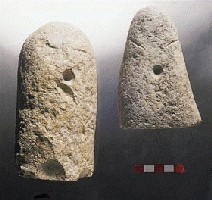Search our Archives:
» Home
» History
» Holidays
» Humor
» Places
» Thought
» Opinion & Society
» Writings
» Customs
» Misc.
|
|
 |
The small clay and stone figurines which are on display until the end of August in the Bible Lands Museum in Jerusalem are an extreme case of late recognition. For years archaeologists have believed that the
Pottery Neolithic period occurring at the end of the Stone Age was a dark age in the history of Israel and the Levant. The recent finds from the village Sha'ar Hagolan show that this was a big mistake. The village was not only a prosperous settlement, but its inhabitants, the Yarmukians, were talented artists.
|
The village was first discovered earlier in this century when inhabitants from a nearby kibbutz dug fishponds in their fields. The site of Sha'ar Hagolan is situated on the southern border of Lake Kinneret, near the river Yarmuk. After the first finds there were some excavations, but the most important ones were only restarted in the nineties. These discoveries are the most extensive found until now in Israel from the Neolithic period.
|

|
It is during these last digs that the stone and clay figurines were unearthed. By now they are already famous in archaeological circles. Very small and droll, the figurines, although all different, have the same bulging eyes and body parts as if they are marshmallow men avant la lettre. They are an intriguing type of expression in what must have been a very prosaic environment.
|
Surely the ancient crafters of the statuettes did not know yet what marshmallows are. The existence of the Yarmukians, so called after their vicinity to the Yarmuk, was basic, devoted to the scraping together of food. Like their forefathers in the earlier part of the Stone Age they were setting up the first experiments in agriculture. Using water from the river they could grow grain. Research shows that wheat and barley were cultivated. In the middle of the village a round building was discovered which was probably a grain silo.
The diet of the Yarmukians was actually quite varied. Besides cultivating the land on which they grew vegetables, olives, and maybe even date and pomegranate trees, they also hunted and gathered food. Some favourite animals for hunting included gazelles, pigeons, waterfowl and migrating birds. They fished in the river, and herded sheep and goats.
Some scientists believe that hunters and pastoralists in the Stone Age were not permanently living in the village but ranged in so-called fringe areas. Indeed, before sites like Sha'ar Hagolan were discovered or sufficiently excavated it was judged that the Pottery Neolithic period consisted only of semi-permanent sites, where the hunters and food-gatherers merely visited a few times per year. On this basis it was concluded that Pottery Neolithic went back to a more primitive stage, with the sites being smaller than in the first part of the Stone Age. Curiously the first excavations in Sha'ar Hagolan seemed to affirm this theory, as only primitive round huts were found. But it was in the recent digs in the nineties that permanent stone dwellings and even one large communal building were excavated, which definitely proved that people had established permanent residence here.
Many artifacts came to the surface. The Yarmukians used weapons and agricultural equipment made of stone. The most frequently used weapon for hunting was the bow. Numerous arrow heads were found, some very delicately cut and retouched. The tools were made from flint heads, selected from stones found in the Yarmuk. There were axes, sickle blades for harvesting, and scrapers, with carefully polished cutting blades.
So far Sha'ar Hagolan does not differ from any Stone Age village. The features that distinguish it as a Pottery Neolithic village are because of two great inventions of this period. The first invention is the use of domesticated animals. The Yarmukians tended cattle, dogs and, in this pre-Jewish time, also pigs. Dual societies, made up of hunters and foodgatherers and devoted to agriculture at the same time, existed not only in the Galilean area, but spread from the Northern Sinai till the Lebanese mountains. The Yarmukian culture encompassed an area from sites in Transjordan and the western Samarian hills along the coast area until what is now the north of Tel Aviv.
The second important invention from Pottery Neolithic is pottery. Pottery was not only valuable as a new technology in itself, but it is also crucial for archaeology. As the pottery of every people and period differs, it is used as one of the foremost identifying tools for the establishing of dates and spreading of trade and cultural influence.
The first known, very crude, pottery finds are from Lebanon. The Yarmukians, who were consequently not the originators of pottery, had a more advanced earthenware, although still very elementary; consisting of open and closed jars, and bowls. The objects were formed by hand, there were no pottery wheels yet. The decorations were painted or incised: triangles, zigzag or herringbone; some with a red painted band.
Sha'ar Hagolan is also different from the average Pottery Neolithic village. From the finds in nearby settlements some more information about the societies in the Stone Age was gathered. One bigger city was Jericho, who's inhabitants were engaged in trade, with Lebanon in greenstone axes; shells, asphalt, sulphur and salt were brought from the Dead Sea, turquoise and other precious stones from the Sinai. In Sha'ar Hagolan no evidence of import or export has yet been found.
|

|
The truly unique feature of the village is their sculpture. Because so little is known yet about the cultures of the Stone Age, of which the Yarmukians are only one example, their carved figurines are even more mysterious. Where did the maker(s) in Sha'ar Hagolan get the idea to make these? Even though Sha'ar Hagolan seemed not involved in trade with other places it is thought that the figurines do not form an isolated example of original artistic inspiration. One of the figurines is of a seated woman with exaggerated hips, holding her breasts. It is thought that she is a fertility goddess. Figurines like this which seem to point to images of a mother goddess are found also in other Neolithic cultures, for example in Anatolia where a large collection of similar figurines is found.
|
Mother or fertility goddesses seem too much of a cliché in trying to explain the riddle of the Yarmukian statuettes. Some of these are just in the form of a head. One figure is curiously bent over. The Yarmukian head sculptures have the same bulging features looking like animal droppings, as the mother goddess, caused by being moulded of small strips of rolled clay. In other words, the figures do not only have fat hips and breasts but also fat eyes and cheeks. Maybe they do not so much symbolise fertility but a longing for abundance in general.
|

|
About the river pebbles which are carved with faces and female sexual organs, the verdict is likewise that they are symbolic of some fertility cult. Because literal sources did not exist in these Prehistoric times it is hard to shed light on the meaning of these figurines and carved pebbles - the Bible or any Near Eastern text were produced long after the Yarmukians were replaced with other cultures. Maybe the makers of the clay puppets and incised pebbles were thinking of god, or of their girlfriends and boyfriends, or they just wanted to bring some life in the monotony of their isolated village.
|
The exhibition about the Yarmukian village in Sha'ar Hagolan in the Bible Lands Museum, Jerusalem will remain on display until 31 August, 1999. Tel. 02-5611066.
~~~~~~~
from the August 1999 Edition of the Jewish Magazine
|
|
Please let us know if you see something unsavory on the Google Ads and we will have them removed. Email us with the offensive URL (www.something.com)
|





|